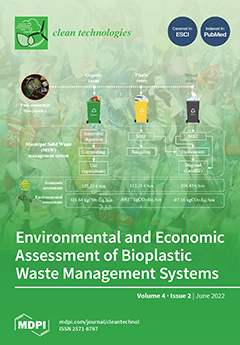This study examined the influence of ohmic heating (
OH), compared to the conventional heating (
Conven) and
Control (solvent) methods, on the extraction of olive mill leaves. The main extraction parameters were: (i) solvent ratio (aqueous ethanol; 40%, 60%, and
[...] Read more.
This study examined the influence of ohmic heating (
OH), compared to the conventional heating (
Conven) and
Control (solvent) methods, on the extraction of olive mill leaves. The main extraction parameters were: (i) solvent ratio (aqueous ethanol; 40%, 60%, and 80%,
v/
v), and (ii) extraction temperature; 45 °C, 55 °C, and 75 °C (for
OH and
Conven), and room temperature (for
Control). The selected response variables were extraction yield (%), total phenolic content (TPC), and antioxidant activity (ABTS and DPPH). The ohmic system, compared to
Conven and
Control, exhibited the greatest effects (
p < 0.001) on increasing (i) extraction yield (34.53%) at 75 °C with 80% ethanol, (ii) TPC at 55 °C (42.53, 34.35, 31.63 mg GAE/g extract, with 60%, 40%, and 80% ethanol, respectively), and (iii) antioxidant potency at 75 °C detected by DPPH and ABTS, in the range of 1.21–1.04 mM TE/g, and 0.62–0.48 mM TE/g extract, respectively. Further, there were relatively similar trends in TPC and antioxidant activity (both methods), regardless of solvent ratios,
p < 0.001. These findings demonstrate the potential of ohmic heating, as a green processing tool, for efficient extraction (15 min) of olive leaves. To date, no literature has described ohmic application for olive leave extraction.
Full article





